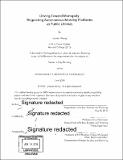Driving toward monopoly : regulating autonomous mobility platforms as public utilities
Author(s)
Wong, Joanne (Joanne Sharon)
DownloadFull printable version (10.44Mb)
Other Contributors
Massachusetts Institute of Technology. Department of Urban Studies and Planning.
Advisor
Amy Glasmeier.
Terms of use
Metadata
Show full item recordAbstract
Autonomous vehicles (AV) have captured the collective imagination of everyone from traditional auto manufacturers to computer software startups, from government administrators to urban planners. This thesis articulates a likely future for the deployment of AVs. Through stakeholder interviews and industry case studies, I show that there is general optimism about the progress of AV technology and its power to positively impact society. Stakeholders across sectors are expecting a future of autonomous electric fleets, but have divergent attitudes toward the regulation needed to facilitate its implementation. I demonstrate that, given the immense upfront capital investments and the nature of network effects intrinsic to data-intensive platforms, the autonomous mobility-as-a-service system is likely to tend toward a natural monopoly. This view is corroborated by key informants as well as recent industry trends. In order to better anticipate the characteristics of this emerging platform, I look back at the developmental trajectories of two classic public utilities - telecommunications and the electricity industry. I argue that the aspiring monopolists in autonomous mobility, like icons in these traditional industries, will succeed in supplanting a legacy technology with a new, transformative one, and use pricing and market consolidation tactics to gain regional dominance. The discussion on monopoly power is then adapted to the new business models of internet-enabled technology giants, and I examine two additional industry case studies in Google and Amazon. I argue that the autonomous mobility platform will first be designed to prioritize scale over everything else, including profits, and that firms are likely to pursue both horizontal and vertical integration strategies to achieve sustained market leadership. I conclude by recommending next steps for reining in platforms that may harm the public interest, and encourage planners to traverse disciplinary boundaries to better facilitate discussions between innovators and regulators.
Description
Thesis: M.C.P., Massachusetts Institute of Technology, Department of Urban Studies and Planning, 2018. Cataloged from PDF version of thesis. Includes bibliographical references (pages 95-101).
Date issued
2018Department
Massachusetts Institute of Technology. Department of Urban Studies and PlanningPublisher
Massachusetts Institute of Technology
Keywords
Urban Studies and Planning.